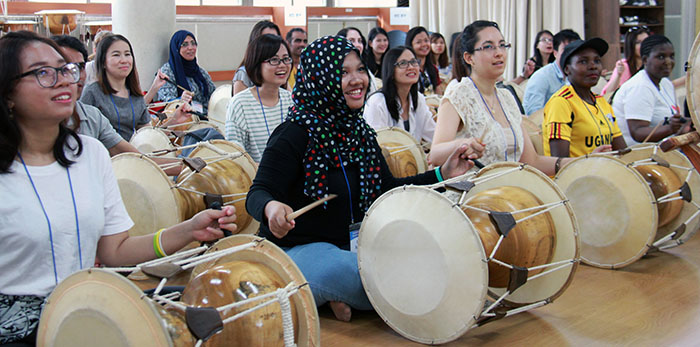
International students and expats learn how to play the traditional janggu drum as part of a program that gives them chances to explore Korea’s UNESCO cultural heritage items and sites, on July 9.
A group of expats and international students has taken a journey to explore two of Korea’s UNESCO cultural heritage items and sites.
On July 9, 97 non-Koreans from 30 countries, including the U.S., Iran, Uzbekistan, India, France, Ghana, Tunisia, Guatemala, Mexico, Laos and Pakistan, had a chance to learn how to play the traditional two-headed janggu (장구) drum, one of instruments used to make nongak (농악), a form of traditional farmer’s music. The class was part of a program hosted by the Korean Culture and Information Service, part of the Ministry of Culture, Sports and Tourism, that was designed to help non-Korean residents in Korea more fully understand the nation’s cultural assets that are registered with UNESCO.
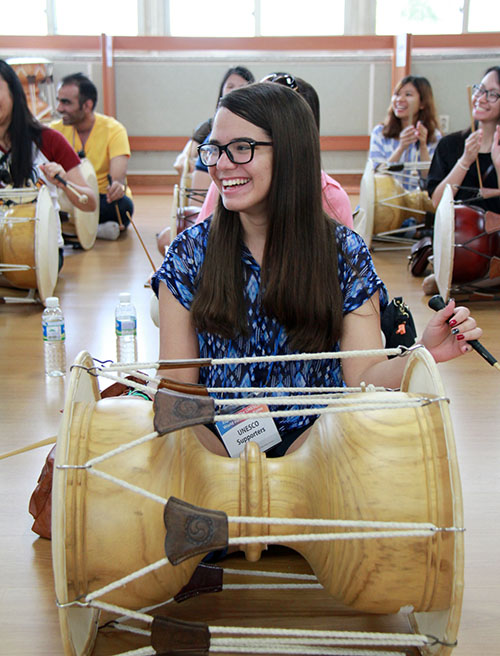
Participants have fun playing the traditional janggu drum on July 9.
Nongak music is played on a variety of percussion instruments, such as the janggu, the kkwaenggwari (꽹과리), a small gong, and the jing (징), a small cymbal, along with dance moves. Its history began with farmers who played and danced, praying to the gods for a good harvest and to fend off evil spirits. In 2014, nongak farmers’ music was inscribed on UNESCO's Intangible Cultural Heritage of Humanity list.
The 30-minute class allowed participants to learn how to hold a pair of janggu drum sticks and gave them a chance to try some simple, easy beats. “We have an equivalent of janggu in Iran, too. The difference between the two instruments, however, is that the Iranian drum should be played with the hands, not with sticks. This is my first time to play this Korean drum, and it's really fun,” said Najafizadeh Sudeh, a 28-year-old participant from Iran who is currently studying for a master’s in textiles and fabric at Hongik University.
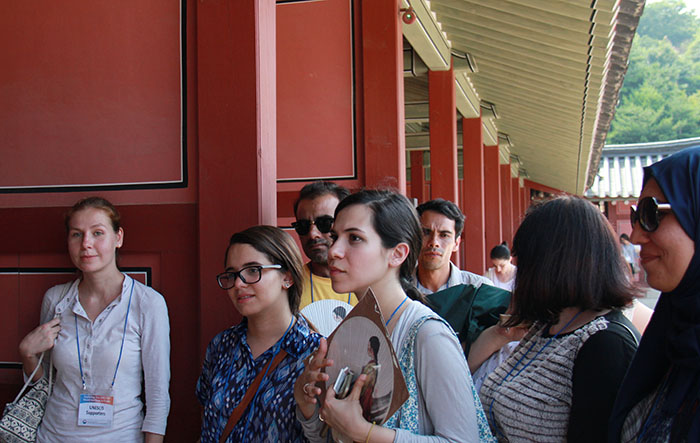
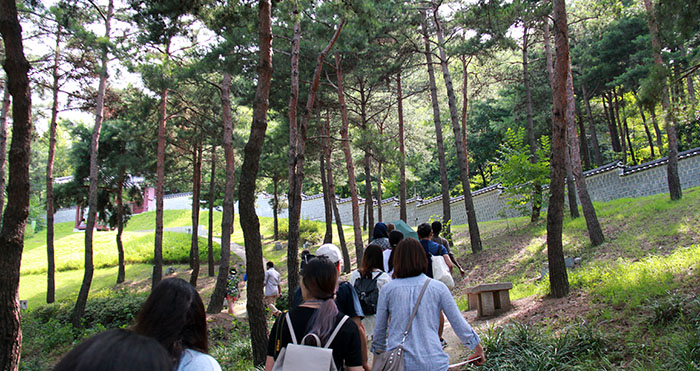
A group of international students and expats visits the Suwon Hwaseong Fortress in Suwon, Gyeonggi-do Province, as part of a program to help non-Korean residents in Korea explore the country's various UNESCO-listed heritage items and sites. They stroll along the fortress walls while being briefed about the history behind the famous castle.
The group was then bussed to the Suwon Hwaseong Fortress in Suwon, Gyeonggi-do Province, a World Cultural Heritage site that was designated by UNESCO in 1997. Covering an area of 371,145 square meters, with ramparts spanning around 5,744 meters, the castle was built by King Jeongjo (정조, 正祖) (1752-1800), the 22nd Joseon monarch, when he decided to move the burial site of his father, Crown Prince Sado, who had died in tragedy, from Baebongsan Mountain in Yangju to Paldalsan Mountain in Suwon.
During their tour, program participants listened to the history of the fortress and of the surrounding buildings. “I could see firsthand the Joseon-era architecture, from the ramparts and buildings here. It was really good to hear about the history that's hidden in some buildings, too,” said Victor Owusu from Ghana who's currently majoring in geography at Seoul National University.
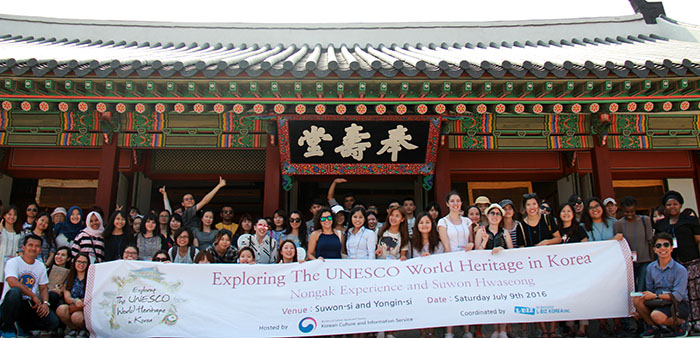
Participants pose for a photo at the Suwon Hwaseong Fortress, a UNESCO World Heritage site in Gyeonggi-do Province, on July 9.
Along with the journey to explore the two UNESCO cultural heritage assets, the group also had hands-on experiences with the bongsan talchum (봉산 탈춤), a traditional mask dance. They visited the Korean Folk Village in Yongin-si, Gyeonggi-do Province, a village that has reconstructed more than 270 traditional Hanok homes that date back to late Joseon times. The village also hosts performances of the jultagi (줄타기), a type of tightrope walking, and nongak music, and is home to a series of exhibitions that give a glimpse into seasonal customs, traditional lifestyles, folk games and farming methods that existed in Joseon.
“With this hands-on experience today, I could see that Korean music and rhythms are a bit different from what I thought and expected,” said Arielle Pukanecz, an English teacher at Seoul Ansan Elementary School. “It was a great chance to understand Korean traditions and history in such a short time.”
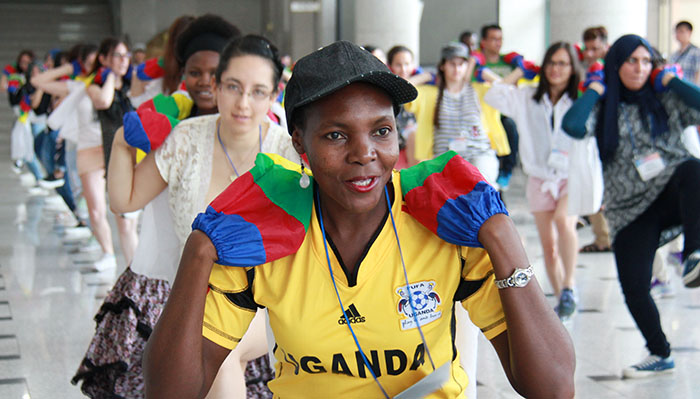
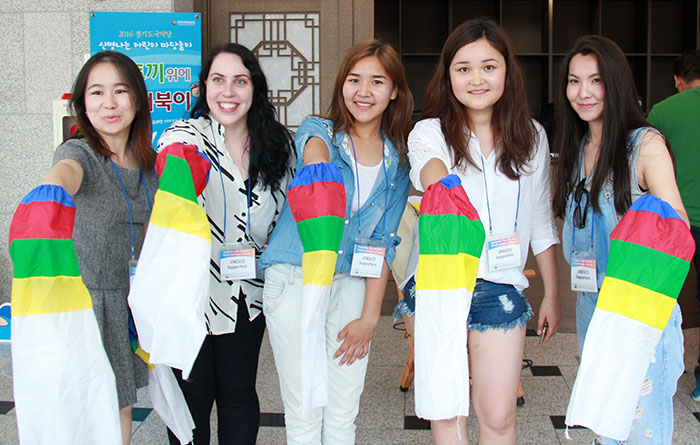
Participants have fun learning the bongsan talchum, a traditional mask dance.
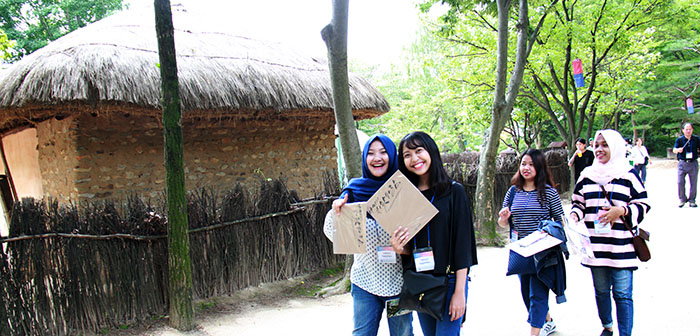
Participants stroll around the Korean Folk Village in Yongin-si, Gyeonggi-do Province, a village of traditional thatched- and tile-roof homes.
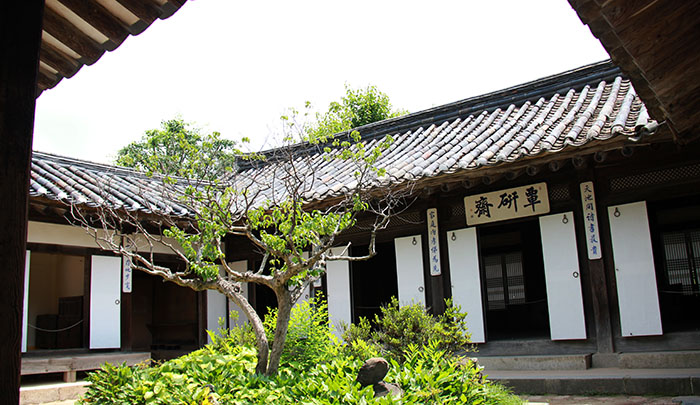
The Korean Folk Village is home to traditional Hanok homes that date back to late Joseon, including a house where a scholar lived (picture).
Article and photos by Sohn JiAe
Korea.net Staff Writer, reporting from Gyeonggi-do Province
jiae5853@korea.kr
Most popular
- Songs from 'KPop Demon Hunters' dominate global Billboard charts
- Council sets minimum hourly wage in 2026 at KRW 10,320
- 28th annual Boryeong Mud Festival to offer more night events
- Songs from animated K-pop film rule Spotify daily chart in US
- Exhibition 'K-Comics World' hawks webtoons in 5 countries
